
Trailing plants, also known as creepers or spillers, form leafy shoots that tend to spill over the edges of pots, walls, and pretty much anything with an incline. These plants tend to have root systems that can grow out of specialized stems, allowing them to spread quickly in a more horizontal manner.
Trailing plants can be placed right along a pond’s edge, at ground level, or elevated in pots to achieve a dramatic cascading effect. This way, the leaves and flowers add more dimension to the water feature and can even create shade for pond-loving amphibians, such as newts and salamanders.
These plants provide the added benefits of covering pond liner and blurring a pond’s edge by creeping into water. Many trailing plants produce colorful flowers and would increase the overall vibrancy of your pond set-up. Some species are water-loving and thrive in high humidity, whereas some require drier, well-draining substrates.
Trailing Plants for Plant Edges
1) Creeping jenny (Lysimachia nummularia)
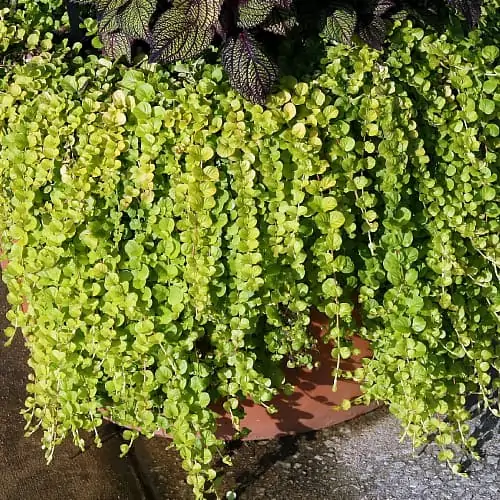
A low-growing herbaceous perennial, Lysimachia nummularia is commonly known as creeping jenny, moneywort, or goldilocks. Characterized by vigorously growing stems, this trailing plant produces small bright-green leaves that may look golden under full sun. Its cup-shaped flowers are bright yellow, occur singly, and bloom throughout the summer to early autumn months. This creeping plant is ideal for pond edges as it can spread to 14 inches wide, leaving delicate trails of rounded foliage.
To generate a dramatic effect, create rocky levels from which the shoots of creeping jenny can spill out and trail towards the water’s surface. This can be situated in pond edge sections that receive full or partial sun. Hardy to USDA zones 4 – 9, L. nummularia thrives best in consistently moist soil. In the wild, this species is usually found along riverbanks, and should thus tolerate pond spray and high humidity without any issues. Though seed-producing, this plant has rhizomes that can even be propagated in water! It’s a no-fuss creeper with the potential to be a pond staple for years. Grow alongside darker-shaded trailing plants to bring out its best features.
Keep in mind that creeping jenny can spread rapidly, and is invasive in some parts of the US. Maintain this plant by trimming it regularly and checking its foliage for decay and disease. If concerned about its rapid spread, try restricting its root system to potted substrates. You may want to consider the ‘Aurea’ cultivar, as the growth rate of this variety is easier to manage.
2) Stonecrop (Sedum spp.)
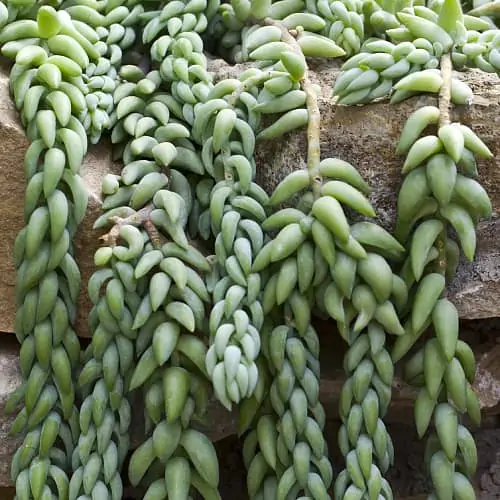
Commonly referred to as stonecrops, sedums are a type of succulent that can grow as mats or produce lengthy hanging shoots with water-storing foliage. Typically known for speckling the landscape in dry areas, sedums come in a wide variety of colors and forms. As plants that favor drought-like conditions, they are found growing out of crevices along rockfaces that are often exposed to harsh conditions. As they prefer well-draining soil, they are best grown in elevated areas around your pond. Hanging containers or tall terracotta pots would best bring out this plant’s attractive features.
Species you may want to consider for your pond edges include burro’s tail (Sedum morganianum) and jelly beans (Sedum rubrotinctum). These produce gracefully trailing stems that will naturally spill out of the rims of pots. If the stems grow too long, the trailing edges can be trimmed, divided, and propagated as cuttings. The crown of the plant will naturally produce more growths that will rapidly lengthen and fill out the edges of a pot.
Hardy to USDA zones 4 – 9, sedums are perennials that produce delicate flowers when provided with minimal requirements. Generally, these plants should not be watered unless the top layer of soil is thoroughly dry. Sedums can withstand seasonal variation and grow dormant during the winter. As temperatures dip, their long stems will typically die back if not pruned beforehand. The good news is many varieties are frost-hardy and will continue to add color around your pond through the cold months!
3) Purple lobelia (Lobelia erinus)
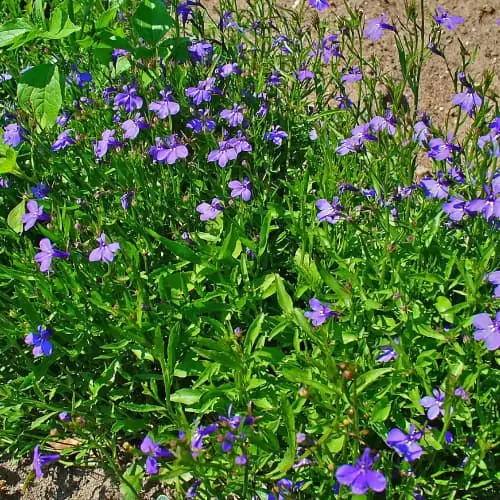
Undeniably pretty, Lobelia erinus is a flowering perennial that is popularly known as purple lobelia, trailing lobelia, or edging lobelia. This is a plant that is made to dapple your pond’s margins! With its vivid blue to purple flowers that bloom in abundance through spring and summer, its trailing shoots attract a host of attractive pollinators, such as butterflies and bees. The linear green leaves of this plant arise from branching stems that can grow up to 9 inches (22 cm) long. Their versatility is best witnessed when allowed to grow from hanging pots and container gardens. Situate your plant along a raised pond edge to leave room for the stems to spill over.
Purple lobelia is generally pest and disease-free. Hardy to USDA zones 10 – 11, it is a tender plant that is generally treated as an annual outside of these zones. It is unable to withstand cooler temperatures and performs best in mild summer weather, under full sun or partial shade. As it is an avid bloomer with a preference for organically rich and evenly moist soil, it thrives best when regularly provided with fertilizer during its growth period. To encourage repetitive blooms, cut back the shoots toward the end of summer.
4) Watercress (Nasturtium officinale)

A trailing plant that your pond’s animal visitors will love? Watercress is a semi-aquatic perennial that is fully edible and is historically recognized as one of the oldest leafy vegetables known to man. It is a member of the mustard family, which includes radish and wasabi. Watercress looks great in a salad, but it is also a prime candidate as a margin plant because it can efficiently blur the edges of your pond. Its herbaceous leaves are pinnately compound and are borne by stems that have evolved to float in water.
In summer, watercress produces small white flowers that attract a variety of insects. Its leaves can thrive in submerged conditions and grow best in slightly alkaline water. To cultivate watercress around your pond, place mature plants (acclimatized to outdoor conditions) in permanently damp soil that has been enriched with organic matter. Keep in mind that watercress is a fast-growing plant that may invade your pond and smother other trailing plants. You may want to consider growing the mature shoots in individual containers so that the roots are prevented from spreading too rapidly.
5) Creeping zinnia (Sanvitalia procumbens)
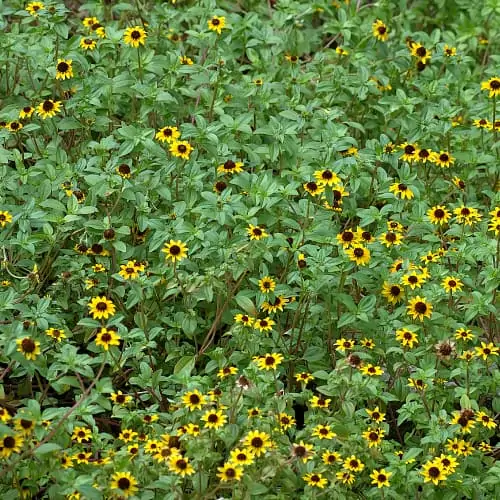
A common garden favorite, Sanvitalia procumbens is a trailing plant that is sure to steal your heart. This adorable annual creeper appears to embody cheer and a positive outlook, as its delicate bright flowers rise up to meet the sun. For this reason, it has also been referred to as miniature sunflower! Creeping zinnia is a perfect pond edge plant that is easy to manage. Its low-growing shoots extend to just 6 – 12 inches (15 – 30 cm), and its spread is typically restricted to within a foot (30 cm) of the crown.
This plant thrives best under full sun and prefers well-draining soil. In the summer, it should be watered every other day so that the sediment does not dry out completely. To encourage a lengthened bloom period, regularly apply fertilizer or use an organic compost that will not endanger your pond’s inhabitants. Hardy to USDA zones 7 – 10, creeping zinnia prefers warm temperatures and is quite heat tolerant. It grows optimally in temperatures close to 21˚C (70˚F).
As this species cannot tolerate overwatered soil, it should be grown along elevated pond edges or in pots that are situated in sunny areas. To accentuate its vibrant yellow flowers, which can grow abundantly enough to block out its foliage, cultivate this plant alongside darker plants or around rocky outcroppings. Creeping zinnia is a low-maintenance species that is relatively pest- and disease-free. Maintain its appearance by pruning leggy growths once the flowering period has passed.
6) Passionflower vine (Passiflora spp.)
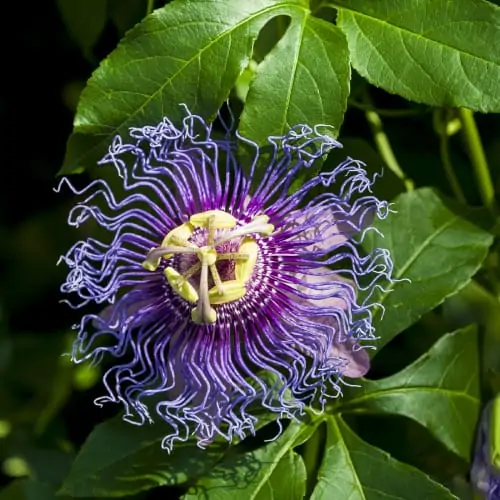
The iconic passionflower plant was named by Christian missionaries who related each flower part to an aspect of the Crucifixion. It belongs to a rich genus of flowering vines, Passiflora, which has around 550 species. Many of these are ornamental plants that are known for producing passion fruit, a delicious crop with many culinary uses. Passionflower vines are grown best in tall containers, which provide the plant with ample height for its shoots and tendrils to fall gracefully. To say that this plant has eye-catching flowers would be an understatement, as passion flowers are unlike any other. Their complex three-dimensional structures have striking colors and forms that are irresistible to many pollinators.
As a trailing plant, passionflowers can be cultivated along the sunniest edges of your pond. It thrives best in high humidity conditions and in moist, well-draining soil. To ensure that your passionflowers bloom in the summer months, incorporate compost into its soil. Hardy to USDA zones 6 – 10, this plant favors warm temperatures and tropical climate conditions. If located in these zones, you may consider creating an elaborate passionflower backdrop for your pond. A trellis would be perfect for accentuating the foliage and flowers of this plant.
Care for your passionflower and reap the rewards by feasting on its fruits! Some of the most popular passionflower varieties include Passiflora ligularis, Passiflora edulis, and Passiflora quadrangularis. Even the flowers of these species are fully edible, and are often used to brew herbal teas that can ease anxiety!
7) Water hyssop (Bacopa monnieri)
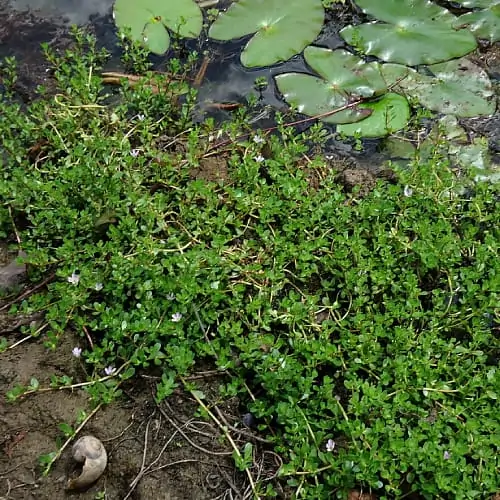
Also called the ‘Herb of Grace’, this wondrous medicinal plant is extremely widespread and has reaped its benefits across the planet. Native to wetlands, this perennial herb is a low-growing creeper that would eagerly welcome a pond-edge position. With a preference for moist soil, this plant is known for having vast root systems that rapidly spread. This must be taken into account when planning where to place your water hyssop. If concerned about widespread growth, you may also opt to grow this plant out of a container or pot from which its bright-green foliage will trail.
A member of the snapdragon family, Bacopa monnieri produces solitary bell-shaped flowers that bloom in late spring to early fall. Its flowers range in color from white to light pink and serve as hosts to caterpillars of the white peacock butterfly. Its flowers are non-fragrant, however, and the plant itself can be invasive if not maintained properly.
Water hyssop thrives best under full sun, which will encourage a fuller appearance. This ornamental plant isn’t too picky when it comes to soil types and conditions, as it will even grow in standing water. Hardy to USDA zones 8 – 11, this plant prefers warm, humid environments and is frost tender. If located outside these zones, make sure to grow your water hyssop in pots that can be transferred indoors during winter.
8) Creeping thyme (Thymus spp.)
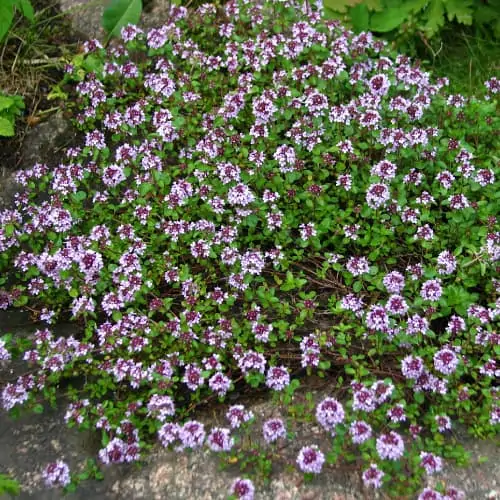
If you’re looking to add a vivid splash of color around your pond, consider growing creeping thyme. With bright flowers that are typically pink-purple in color, this hardy perennial herb can spread quickly under moderate climate conditions. Their trailing shoots have the tendency to form low-growing mats that produce a fragrance similar to that of thyme used in the kitchen. Like its cousin, some species of creeping thyme are known for being edible and are used to make herbal teas.
Creeping thyme comes in a wealth of colorful varieties that have the capacity for being ideal ground cover options. Typically, their shoots grow to a height of just 3 inches (7.6 cm) but are not easily overlooked! As an added bonus, this plant’s creeping habit can help keep your pond edges neat by preventing the growth of invasive weeds. To draw attention to its trailing shoot systems, situate your creeping thyme along an elevated section of your pond edge. The elevation will also aid in keeping its roots regularly moist, but not wet.
Hardy to USDA zones 4 – 9, this plant is relatively low-maintenance as it can thrive in a variety of soils and under sunny to shaded exposures. When planting creeping thyme, ensure that you leave ample space between each individual plant so that their roots may spread easily. Species to consider include Thymus praecox, and Thymus serpyllum. If you’re drawn to more muted colors, make sure to look for Thymus paocos ‘Albiflorus’, which has soft white blooms for a classier look.


Hi, so glad I found your site, have a 1700 gallon pond in south Florida and struggling to keep fish healthy. We do have it covered from the hot sun with a trellace which has a thick Garlic vine on it. Do you think it is possible that it has something that can kill the fish in any part of the plant? leaves, blossoms, etc? Thank you.